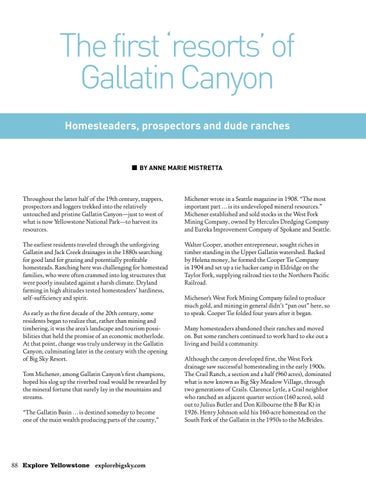The first ‘resorts’ of Gallatin Canyon Homesteaders, prospectors and dude ranches
BY ANNE MARIE MISTRETTA
Throughout the latter half of the 19th century, trappers, prospectors and loggers trekked into the relatively untouched and pristine Gallatin Canyon—just to west of what is now Yellowstone National Park—to harvest its resources.
Michener wrote in a Seattle magazine in 1908. “The most important part … is its undeveloped mineral resources.” Michener established and sold stocks in the West Fork Mining Company, owned by Hercules Dredging Company and Eureka Improvement Company of Spokane and Seattle.
The earliest residents traveled through the unforgiving Gallatin and Jack Creek drainages in the 1880s searching for good land for grazing and potentially profitable homesteads. Ranching here was challenging for homestead families, who were often crammed into log structures that were poorly insulated against a harsh climate. Dryland farming in high altitudes tested homesteaders’ hardiness, self-sufficiency and spirit.
Walter Cooper, another entrepreneur, sought riches in timber standing in the Upper Gallatin watershed. Backed by Helena money, he formed the Cooper Tie Company in 1904 and set up a tie hacker camp in Eldridge on the Taylor Fork, supplying railroad ties to the Northern Pacific Railroad.
As early as the first decade of the 20th century, some residents began to realize that, rather than mining and timbering, it was the area’s landscape and tourism possibilities that held the promise of an economic motherlode. At that point, change was truly underway in the Gallatin Canyon, culminating later in the century with the opening of Big Sky Resort. Tom Michener, among Gallatin Canyon’s first champions, hoped his slog up the riverbed road would be rewarded by the mineral fortune that surely lay in the mountains and streams. “The Gallatin Basin … is destined someday to become one of the main wealth producing parts of the county,”
88 Explore Yellowstone explorebigsky.com
Michener’s West Fork Mining Company failed to produce much gold, and mining in general didn’t “pan out” here, so to speak. Cooper Tie folded four years after it began. Many homesteaders abandoned their ranches and moved on. But some ranchers continued to work hard to eke out a living and build a community. Although the canyon developed first, the West Fork drainage saw successful homesteading in the early 1900s. The Crail Ranch, a section and a half (960 acres), dominated what is now known as Big Sky Meadow Village, through two generations of Crails. Clarence Lytle, a Crail neighbor who ranched an adjacent quarter section (160 acres), sold out to Julius Butler and Don Kilbourne (the B Bar K) in 1926. Henry Johnson sold his 160-acre homestead on the South Fork of the Gallatin in the 1950s to the McBrides.














